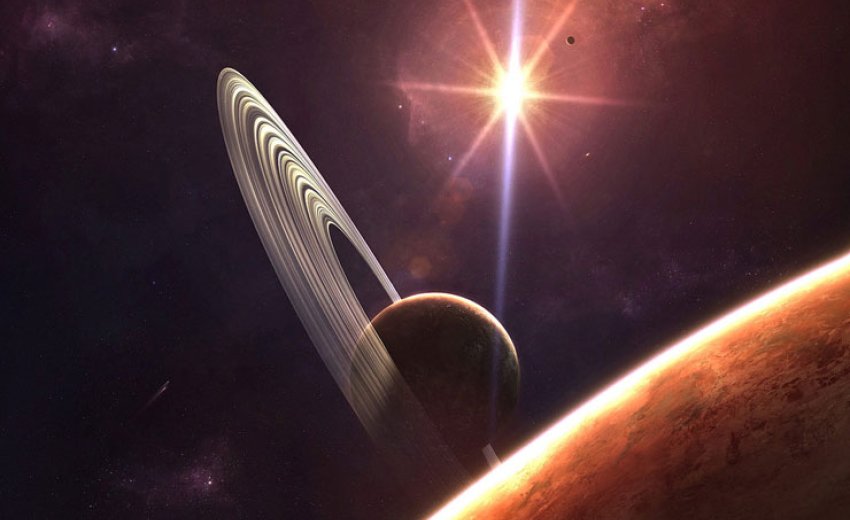Laws of Nature and Laws of Science
Dr Dalvinder Singh Grewal
"The very success of the scientific method depends upon the fact that the physical world operates according to rational principles which can therefore be discerned through rational enquiry. Logically, the universe does not have to be in this way. We could conceive of a cosmos where chaos reigns. In place of the orderly and regimented behavior of matter and energy one would have arbitrary and haphazard activity. Stable structures like atoms or people or stars could not exist. The real world is not this way. It is ordered and complex. Is that not itself an astonishing fact at which to marvel."1
The other greatest scientific minds too have stood in awe at the information content and intelligent order exhibited throughout the universe:
Max Planck-"At all events we should say, in summing up, that, according to everything taught by the exact sciences about the immense realm of nature in which our tiny planet plays an insignificant role, a certain order prevails-one independent of the human mind. Yet, in so far as we are able to ascertain through our senses, this order can be formulated in terms of purposeful activity. There is evidence of an intelligent order of the universe."2
Albert Einstein-"Well, a priori [reasoning from cause to effect] one should expect that the world would be rendered lawful [obedient to law and order] only to the extent that we [human beings] intervene with our ordering intelligence . . [But instead we find] in the objective world a high degree of order that we were a priori in no way authorized to expect. This is the `miracle' that is strengthened more and more with the development of our knowledge."3
Sir James Jeans-"Our efforts to interpret nature in terms of the concepts of pure mathematics have, so far, proven brilliantly successful."4
Sir Isaac Newton-"The six primary planets are revolving about the sun in circles concentric with the sun, and with motions directed towards the same parts, and almost in the same plane. Ten moons are revolving about the earth, Jupiter, and Saturn, in circles concentric with them, with the same direction of motion, and nearly in the planes of the orbits of those planets;-but it is not to be conceived that mere mechanical causes could give birth to so many regular motions, since the comets range over all parts of the heavens in very eccentric orbits."5
Scientists recognize that there is a strong quality running through nature all about us that enables life to exist on our planet. This is called the "anthropic principle." It appears that water, atmosphere, chemicals-were all perfectly designed for living things to exist, and, in special sense, for mankind to exist.
 Guru Nanak has stated this in better terms, "Air, water and fire created the life."6" "This is a play of active mayopic intelligence by combining air, water and fire,"7 He clarifies the creation of the universe, "He created from light the air, soil and environment and established the five elements in this."8
Guru Nanak has stated this in better terms, "Air, water and fire created the life."6" "This is a play of active mayopic intelligence by combining air, water and fire,"7 He clarifies the creation of the universe, "He created from light the air, soil and environment and established the five elements in this."8
This is quite obvious to any thinking individual who is willing, without prejudice, to consider the things of nature in our world and outside of it. There is a grand design in the Universe that favours the development of intelligent life. This claim, in certain variations, is the `anthropic cosmological principle.' "9
The delicate balance
The basic forces of matter and the universe are astounding. They could not have come into existence by accident. There are several basic forces in nature which would destroy the universe-or not let it form-were it not for the delicate balance within each of them. Here is scientific evidence. God created everything; the evidence clearly points to it.
The smallest change in any of the circumstance of the natural work, such as the relative strengths of the forces of nature or the properties of the elementary particles, would have led to a Universe in which there could be no life and no man."10
1 - Gravity. Gravity is the weakest force in the universe, yet it is in perfect balance. If gravity were any stronger, the smaller stars could not form; and, if it were any smaller, the bigger stars could not form and no heavy elements could exist. Only "red dwarf" stars would exist, and these would radiate too feebly to support life on a planet.
All masses are found to attract one another with a force that varies inversely as the square of the separation distance between the masses. That, in brief, is the law of gravity. But where did that "2" [square] come from? Why is the equation exactly "separation distance squared"? Why is it not 1.87, 1.92, 2.001, or 3.378; why is it exactly 2? Every test reveals the force of gravity to be keyed precisely to that 2. Any value other than 2 would lead to an eventual decay of orbits,-and the entire universe would destroy itself!
(Another example would be the inverse-square law, which is often mentioned in connection with the red-shift and the visibility of quasars. According to this law, light diminishes exactly according to the square of its distance from the observer, not 1.8, .97, or some other fraction, but exactly 2.)
2 - Proton to neutron ratio. A proton is a subatomic particle found in the nucleus of all atoms. It has a positive electric charge that is equal to the negative charge of the electron. A neutron is a subatomic particle that has no electric charge. The mass of the neutron must exceed that of the proton in order for the stable elements to exist. But the neutron can only exceed the mass of the proton by an extremely small amount-an amount which is exactly twice the mass of the electron. That critical point of balance is only one part in a thousand. If the ratio of the mass of the proton to neutron were to vary outside of that limit-chaos would result.
The proton's mass is exactly what it should be in order to provide stability for the entire universe. If it were any less or more, atoms would fly apart or crush together, and everything they are in-which is everything!-would be destroyed. If the mass of the proton were only slightly larger, the added weight would cause it to quickly become unstable and decay into a neutron, positron, and neutrino. Since hydrogen atoms have only one proton, its dissolution would destroy all hydrogen, and hydrogen is the dominant element in the universe. A master Designer planned that the proton's mass would be slightly smaller than that of the neutron. Without that delicate balance the universe would collapse.
3 - Photon to baryon ratio. A photon is the basic quantum, or unit, of light or other electromagnetic radiant energy, when considered as a discrete particle. The baryon is any subatomic particle whose weight is equal to or greater than that of a proton. This photon-to-baryon ratio is crucial. If it were much higher than it is, stars and galaxies could not hold together through gravitational attraction.
4 - Nuclear force. It is the nuclear force that holds the atoms together. There is a critical level to the nuclear force also. If it were larger, there would be no hydrogen, but only helium and the heavy elements. If it were smaller, there would be only hydrogen, and no heavy elements. Without hydrogen and without heavy elements there could be no life. In addition, without hydrogen, there could be no stable stars. If the nuclear force were only one part in a hundred stronger or weaker than it now is, carbon could not exist-and carbon is the basic element in every living thing. A 2 percent increase in the nuclear force would eliminate protons.
5 - Electromagnetic force. Another crucial factor is the electromagnetic force. If it were just a very small amount smaller or larger, no chemical bounds could form. A reduction in strength by a factor of only 1.6 would result in the rapid decay of protons into leptons. A three-fold increase in the charge of the electron would render it impossible for any elements to exist, other than hydrogen. A three-fold decrease would bring the destruction of all neutral atoms by even the lowest heat-that found in outer space.
It is of interest that, in spite of the delicate internal ratio balance within each of the four forces (gravitation, electromagnetism, and the weak and strong forces), those four forces have strengths which differ so greatly from one another that the strongest is ten thousand billion billion billion billion times more powerful than the weakest of them. Yet evolutionary theory requires that all four forces originally had to be the same in strength-during and just after the beginning of the universe!
We are here dealing with the basic properties of matter. The proton-to-neutron mass ratio is what it has always been-what it was since the Beginning! It has not changed, it never will change. It began just right; there was no second chance! The same is with all the other factors and balances to be found in elemental matter and physical principles governing it.
"There is another aspect of modern astronomical discoveries that is, in my view, as remarkable as the evidence for the abrupt birth of the Universe. … the smallest change in any of the circumstance of the natural work, such as the relative strengths of the forces of nature or the properties of the elementary particles, would have led to a Universe in which there could be no life and no man."11
There are many other examples that could be cited in nature which require the most delicate of balancing in order for the stars, planets, life, and mankind to exist.
Before concluding this discussion, we will consider but one more: the distance that the moon is from the earth. If it were much closer, it would crash into our planet, if much farther away, it would move off into space.
If it were much closer, the tides that the moon causes on the earth would become dangerously larger. Ocean waves would sweep across low-lying sections of the continents. Resultant friction would heat the oceans, destroying the delicate thermal balance needed for life on earth.
A more distant moon would reduce tidal action, making the oceans more sluggish. Stagnant water would endanger marine life, yet it is that very marine life that produces the oxygen that we breath. (We receive more of our oxygen from ocean plants than from land plants.) Why is the moon so exactly positioned in the sky overhead? Who placed it there? It surely did not rush by like a speeding train, then decide to pause, and carefully enter that balanced orbit.
Guru Nanak rightly said, "Everything is subject to Lord's order, No one is beyond His Order"12
-------------------------------------------
1 P. Davies, Superforce: The Search for a Grand Unified Theory of Nature (1984), p. 223.
2 Max Planck, May 1937 address, quoted in A. Barth, The Creation (1968), p. 144.
3 Albert Einstein, Letters to Maurice Solovine (1956), pp. 114-115.
4 Sir James Jeans, The Mysterious Universe (1930), p. 143.
5 Sir Isaac Newton, Mathematical Principles (2nd Ed, 1686), pp. 543-544
6Pavnai paanee agni jeeo payia. (p.1031)
7Paunai paanee agnee ka mel(u) chanchal chapal budh(I) ka khel(u) (p.152)
8 Ap(u) tej(u) vae prithmi aakasa. Tin mah(i) panch tat(u) ghar(i) vaasa. (p.1o31)
9 W. Press, "A Place for Teleology?" in Nature 320 (1986), p. 315.
10 Robert Jastrow, "The Astronomer and God," in The Intellectuals Speak Out About God,1984, p. 15.
11 Robert Jastrow, "The Astronomer and God," in The Intellectuals Speak Out About God (1984), p. 15. [Jastrow classifies himself as an agnostic.]
12 Hukmai andar sabh ko baahar hukam na ko-ay. Everyone is subject to His Order; no one is beyond His Order.





